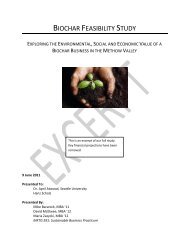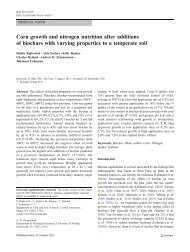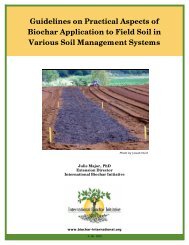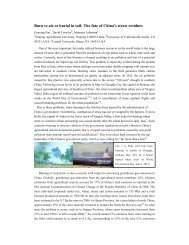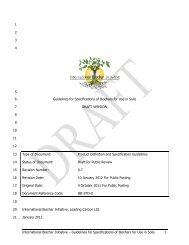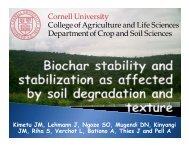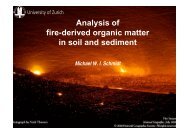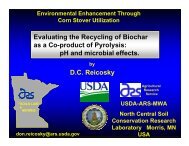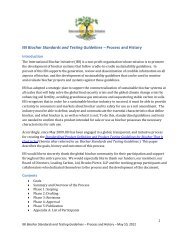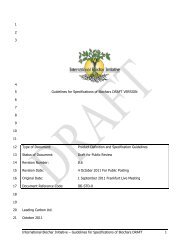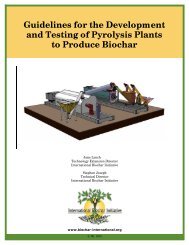1 Functional substances obtained through biomass pyrolysis
1 Functional substances obtained through biomass pyrolysis
1 Functional substances obtained through biomass pyrolysis
Create successful ePaper yourself
Turn your PDF publications into a flip-book with our unique Google optimized e-Paper software.
acids), alcohols (e.g., methanol, acetoin, and cyclotene), and neutral <strong>substances</strong> (e.g., acetone andfurfural) are generated mainly from hemicellulose and cellulose 10) . Phenol components (e.g.,phenol and cresol) are generated mainly <strong>through</strong> the decomposition of lignin 11) . Acetic acid, theprincipal component of acid liquid, is generated <strong>through</strong> the decomposition of the acetyl group ofhemicellulose and the carboxyl group of uronic acid in wood. Methanol is generated mainly fromthe methoxyl groups of components 1, 2, 12, 13) .Figure 2. Odor components of acid liquid and bamboo vinegar4. Odors of acid liquid and bamboo vinegarThe smoke generated during the thermal decomposition of woods or bamboos in acharcoal kiln has peculiar odors. The acid liquid and bamboo vinegar generated by cooling thesmoke has the same odors. The thermal decomposition products of woods or bamboos have4
Acid liquid has various functions. These functions have been applied in many ways.Sales according to the applications of acid liquid are shown in Table 3 16) . Acid liquid is mainlyused for agriculture, livestock, and feedstuff. Table 4 shows recent investigations on theapplications of acid liquid and bamboo vinegar 17-30) . The antibacterial properties of acid liquidand bamboo vinegar have been known empirically and investigated for a long time. We haveinvestigated the antibacterial properties and functions of acid liquid and bamboo vinegar. Ourinvestigations will be discussed below.Table 3. Sales according to the applications of acid liquid in 2000Applications Sales (ton) %Agriculture 5,232.3 65.1Golf course 7.7 0.1Livestock 412.1 5.2Feedstuff additive 530.8 6.6Repellent 66.1 0.8Food industry 1,128.7 14.1Deodorant 264.6 3.3Bath 349.3 4.3Disinfectant 3.7 0.0Greening and gardening 1.3 0.0Others 41.5 0.5Total 8,038.1 100.0*: Prepared based on surveys by the Japan Charcoal and Fuel Association.Table 4. Investigations on the applications of acid liquid and bamboo vinegarKindsAcid liquidandamboo vinegarInvestigations on the applications of acid liquid and bamboo vinegarDeodorant 17) , Smoke liquid (flavor, etc.) 17)Compost manufacturing 6) , Dyeing (dyeing of wood, etc.) 17)Feedstuff additive 18) , etc.6
Antibacterial and antifungal properties(soil bacteria 19) , damping-off pathogens of needle-leaved trees 20) , soil-bornewheat mosaic virus 21) , Trichophyton 22) , etc.)Nematocide 23) , Deodorant 24) 8, 17), AntioxidantFeedstuff additive (egg production, etc.) 25)Insect repellent and insecticide (stink bug 26) , fly 27) , etc.)28, 29)Plant growth regulatorMushroom fruit-body formation stimulant 30) , etc.5-1. Antioxidative properties of acid liquidBesides bacterial decomposition, the oxidization of dietary lipid (oil) is a major cause offood deterioration. Lipid oxidation generates various oxidized products. The oxidized productsmay cause sour odors and toxicities 31) . Antioxidants play an important role in preventing these.Smoke liquid and odor have traditionally been used for foods mainly because of theirantioxidative activities. Tilgner reported the antioxidative activities of smoke. The antioxidativeactivities are mainly caused by phenolic compounds 32) . Acid liquid may contain similarcomponents. Thus, the antioxidative activities of acid liquid were investigated 8) . Figure 3 showsthe antioxidative activities determined by the iron thiocyanate method. Bamboo vinegar andquercus acid liquid had higher antioxidative activities than those of α-tocopherol, a well-knownnatural antioxidant. Larch acid liquid had high antioxidative activities, although lower than thoseof α-tocopherol. Antioxidative activities vary with measurement methods. However, theantioxidative activities of acid liquid were comparable between iron thiocyanate and othermethods. Of acid liquid components, syringyl phenolic compounds had markedly highantioxidative activities. These <strong>substances</strong> were relatively abundant in acid liquid made frombroad-leaved trees (e.g., quercus) and bamboo vinegar, but were scarce in needle-leaved trees(e.g., larch). These results suggest the usefulness of acid liquid made from broad-leaved trees andbamboo vinegar as antioxidants.7
Figure 3. Antioxidative activity of acid liquid extracted with benzene, determined by the ironthiocyanate method.5-2 Functions of acid liquid odorsare given below.Distinctive acid liquid odors may have effects on various organisms. Study examples5-2-1 Acid liquid odors as plant growth regulatorsThe effects of acid liquid and bamboo vinegar odors, generated at around roomtemperature, on plant growth, etc., are shown in Figure 4 15) . Acid liquid and bamboo vinegarmarkedly suppress plant growth. The suppressive activity was enhanced by increasing the testliquid, suggesting the involvement of odor components. Major odor <strong>substances</strong> were investigatedto explore <strong>substances</strong> involved in the suppressive activity. The results are shown in Figure 5. Allthe odor <strong>substances</strong> suppressed plant growth. Of these <strong>substances</strong>, acetic acid, acetic acid methyl8
ester, and furfural had marked suppressive activities. The suppressive activities remained higheven if the amounts were reduced to one-tenth. Acid liquid odors can transiently, but notcompletely suppress plant budding and growth depending on their amounts. Thus, a acid liquidsolution is not sprayed on leaves, but acid liquid odor is diffused into the atmosphere. Forexample, acid liquid should be used to adjust the shipping time of crops grown in greenhouses andcontrol plant growth in nurseries.Figure 4. Effects of acid liquid and bamboo vinegar odors on plant growth*: Percentages of the control value (%)9
Figure 5. Effects of the principal odor components of acid liquid and bamboo vinegar on plant(radish) growth*: Percentages of the control value, Mean ± SD (N=10)5-2-2 Acid liquid odors as bacterial growth suppressorsThe effects of acid liquid odors on bacteria have also been investigated. Terashita et al.33) investigated the effects of volatile acid liquid on bacteria. As a result, the mycelial growth ofplant disease pathogens (Fusarium oxysporum, Rhizoctonia solani, and Rosellinia necatrix) wasinhibited (Figure 6). Additionally, components other than acid liquid odor components did notinhibit mycelial growth, suggesting the antibacterial effects of the odor components. Furthermore,Terashita et al. 33) investigated acetic acid, a major odor component, to identify an antibacterialsubstance, and demonstrated that acetic acid completely inhibited mycelial growth at the sameconcentration as the acetic acid contained in acid liquid.10
Figure 6. Effects of volatile quercus acid liquid on the mycelial growth of plant diseasepathogens6. Properties of acid liquid made from the waste materials of construction and forest landsRecently, various waste materials are being carbonized for resource recycling. Theproperties of charcoal and thermal decomposition liquid <strong>obtained</strong> <strong>through</strong> wood <strong>pyrolysis</strong> havebeen investigated. Study examples on the waste materials of construction and forest lands aredescribed below.6-1 Acid liquid made from medium-density fiberboardMedium-density fiberboard (MDF) is a main wood material used for construction andfurniture. Pyrolysis has attracted attention as a procedure for resource recycling. Acid liquid<strong>obtained</strong> by carbonizing the material may be contaminated with the thermal decompositionproducts of adhesive besides natural wood. Thus, the acid liquid may have a distinctive odor.Table 5 shows the analytical results of acid liquid made from MDF with urea resin applied as anadhesive. Nitrogen-containing compounds were extracted from detected <strong>substances</strong> 34) . Twenty<strong>substances</strong> were detected and identified, suggesting that various nitrogen-containing compoundswere contained. These <strong>substances</strong> were barely detectable in acid liquid made from wood,suggesting that they were generated <strong>through</strong> the reaction of urea resin or reaction between urea11
esin and wood. Some of these <strong>substances</strong> may be hazardous. Thus, acid liquid should be usedwith caution for safety reasons. No conclusion can be drawn for all materials from this study onMDF. However, caution should be exercised when using acid liquid made from materialscontaining artificial <strong>substances</strong>.Table 5. Components of acid liquid made from MDFCarbonizedsamplesMDFNitrogen-containing compounds in acid liquidTriethlamine, pyridine, pyrazine, 2-Methy-pyridine, N-Methyl-formamide,N, N-Dimethyl-formamide, Methyl-pyradine, Methyl-pyrimidine,N, N-Dimethyl-acetamide, N-Methyl-propanamide, Methyl-1H-imidazole,Acetamide, Propanamide, 2-Pyrimidinamine, Butanamide,2-Amino-4-methylpyrimidine, N, N-Dimethyl-urea, Trimethyl-isocyanurate,Methyl-1H-pyrazole, 3-PyridinolUrea resinAcetnitrile, N, N-Dimethyl-formamide, 2-Pyrimidinamine, N-Methyl-formamide6-2 Acid liquid made from the waste materials of forest lands (needle-like leaves of cedar)Cedar, a representative forest tree in Japan, is frequently used for construction. However,needle-like leaves produced in large amounts during tree trimming and pruning are barely used.Their efficient use for resource recycling is desired. In the present study, the <strong>pyrolysis</strong> ofneedle-like leaves of cedar was investigated to find some interesting properties of <strong>pyrolysis</strong>products. Needle-like leaves air-dried for about 1 hour (dried leaves) were processed in a simple<strong>pyrolysis</strong> furnace to generate a thermal decomposition liquid like acid liquid. This acid liquid-likeliquid was compared with acid liquid to demonstrate that this liquid contained terpenes in smallamounts, phenols at the same percentages as those of acid liquid, and furans and cyclopentanes atlower percentages than those of acid liquid. Fatty acids contained at high percentages includedacetic, hexadecanoic, 14-pentadecenoic, propanoic, pentadecanoic, octanoic, and butanoic acids.The terpenes included monoterpenes (α-pinene, sabinene, limonene, etc.) and diterpenes(16-kaurene, ferrugino, etc.), which are contained in essential oils at high percentages 35) . Thus,the thermal decomposition liquid <strong>obtained</strong> from dried cedar leaves contained known biological12
<strong>substances</strong> in large amounts, suggesting various potential functions.7. ConclusionsPyrolysis is a promising recycling procedure for <strong>biomass</strong>. More beneficial <strong>pyrolysis</strong>products will be effectively utilized. More efficient <strong>pyrolysis</strong> procedures should be developed torecycle <strong>biomass</strong> resources generated in large amounts.References1) K. Minami, K. Kawamura: Journal of Forest Research, 40 (2), 61-67 (1958)2) K. Minami, H. Orii, K. Kawamura: Journal of Forest Research, 39 (12), 474-479 (1957)3) T. Shibamoto, K. Minami: Journal of Forest Research, supplement, 48-52 (1952)4) T. Shibamoto, K. Minami: Journal of Forest Research, 34, 77-82 (1952)5) Forest Experiment Station, Handbook of Wood Technology 3rd edition, Maruzen, 905 (1982)6) M. Yatagai, G. Unrinin, T. Ohira: Mokuzai Gakkaishi, 34 (2), 184-188 (1988)7) M. Fujimaki, K. Kim, T. Kurata: Agr. Biol. Chem., 38 (1), 45-52 (1974)8) N. Matsui, T. Ohira, M. Yatagai: Summary of the 51st Annual Meeting of the Japan WoodResearch Society, 385 (2001)9) N. Ogata, T. Baba: Research Communications in Chemical Pathology and Pharmacology, 66(3), 411423 (1989)10) R. T. Schwenker, L. R. Beck: J. Polymer Sci. part C. 2, 331 (1963)11) T. L. Fletcher, E. E. Harris: Tappi, 35. 536 (1952)12) K. Minami, K. Kawamura, N. Oshima: Journal of Forest Research, 40 (2), 68-79 (1958)13) M. M. Tang, R. Bacon: Carbon, 2, 211 (1957)14) S. Kishimoto, K. Hirano, H. Yamakawa: Journal of the Japan Wood Research Society, 16 (8),p.382-387 (1970)15) T. Mizoguchi, T. Ohira, N. Matsui, M. Yatagai: Summary of the 49th Annual Meeting of theJapan Wood Research Society, p.398 (1999)16) Japan Charcoal and Fuel Association: New Applications of Charcoal, 9, 1-6 (2001)17) S. Kishimoto, Sanrin, 1130, p.27-33 (1978)18) T. Sakaida, K. Shioya, T. Tanaka: Japanese Journal of Poultry Science, 24 (1), 44-49 (1987)13
19) Y. Miyamoto: Agriculture and Horticulture, 36 (10), 1637-1640 (1961)20) Y. Nohara, Y. Zinno: Research Report of Forest Experiment Station, 96, p.105-128 (1957)21) Y. Miyamoto: Journal of General Plant Pathology, XXVI (3). p.90-97 (1961)22) F. Ikegami, T. Sekine, Y. Fujii: Journal of the Pharmaceutical Society of Japan23) T. Saegusa: Journal of General Plant Pathology, XIX p.185-188 (1955)24) M. Yatagai, T. Ohira, K. Hori: Japanese Patent Application No.2001-1650325) T. Sakaida, K. Shioya, T. Tanaka: Japanese Journal of Poultry Science, 24 (6), 374-377 (1987)26) Y. Niimi, M. Yatagai, A. Shibata: Summary of the 50th Annual Meeting of the Japan WoodResearch Society, 447 (2000)27) M. Takei: Bulletin of Tokai Regional Fisheries Research Laboratory, 46, 61-68 (1966)28) K. Nanamiya: Kanagawa Prefectural Forest Experiment Station, (8), 1-4 (1962)29) M. Yatagai, G. Unrinninn: Mokuzai Gakkaishi, 35 (6). 564-571 (1989)30) H. Yoshimura, T. Hayakawa: Trans. Mycol. Soc. Japan, 34, 141-151 (1993)31) O. Igarashi, T. Kaneda, H. Fukuba, M. Mino: Lipid peroxide and nutrition, Koseikan, Tokyo,198632) S. Kishimoto, Sanrin, 1130, p.27-33 (1978)33) Y. Zinno: Research Report of Forest Experiment Station, 96, p.129-144 (1957)34) Y. Tomimura, T. Ohira: Summary of the 18th Annual Meeting of Wood TechnologicalAssociation of Japan, p.71 (2000)35) E. Kawaguchi, S. Ohya, T. Ohira, N. Matsui, M. Yatagai: Summary of the 52nd AnnualMeeting of the Japan Wood Research Society, p.619 (2002)14



